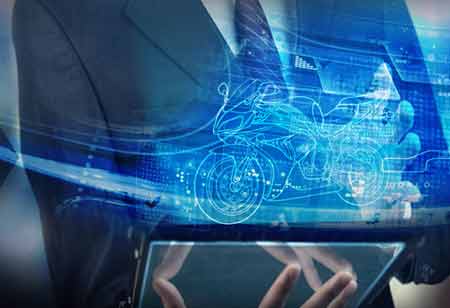THANK YOU FOR SUBSCRIBING
THANK YOU FOR SUBSCRIBING
Be first to read the latest tech news, Industry Leader's Insights, and CIO interviews of medium and large enterprises exclusively from Auto Tech Outlook

By
Auto Tech Outlook | Friday, September 06, 2024
Stay ahead of the industry with exclusive feature stories on the top companies, expert insights and the latest news delivered straight to your inbox. Subscribe today.
AI transforms electric vehicles by optimizing charging, enhancing battery management, and advancing autonomous driving. It also improves grid integration and makes driving a more sustainable and efficient future for transportation.
FREMONT, CA: AI drives transformative changes in the EV industry by optimizing charging, enhancing battery management, advancing autonomous driving, personalizing user experiences, integrating with the electrical grid, and improving charging infrastructure. It makes electric vehicles more efficient, reliable, and aligned with sustainable energy goals. Here’s how AI is making an impact:
Optimized Charging
Smart Charging: Optimize EV charging by scheduling based on grid demand, energy prices, and renewable energy availability. This minimizes energy costs and balances grid load. Vehicles are charged at the most efficient times, enhancing energy efficiency. The approach reduces peak demand and effectively utilizes renewable sources, leading to cost savings and better grid management.
Predictive Maintenance: Analyzes operational data and usage patterns and predicts when charging stations need maintenance. It identifies potential issues before they cause failures, reducing unexpected downtime and ensuring charging stations remain reliable and operational. Proactive maintenance enhances service quality and reduces repair costs, helping schedule timely interventions to avoid disruptions.
Enhanced Battery Management
Battery Health Monitoring: Examines battery data to predict its health and longevity performance and wear helps schedule timely maintenance, reducing the risk of unexpected battery failures. Early detection of issues ensures better reliability and extended battery life. The approach supports proactive management and efficient operation.
Battery Optimization: Adjusts charging patterns to enhance battery life, performance usage, and charging behavior to prevent overcharging and deep discharges, leading to efficient battery use and lifespan. Optimized charging schedules improve battery health and reduce degradation, resulting in a reliable and long-lasting battery.
Autonomous Driving
Navigation and Route Planning: This system optimizes EV routes by analyzing traffic, weather conditions, and nearby charging stations. It reduces travel time and helps avoid delays. It also addresses range anxiety by ensuring routes include available charging options. The system improves efficiency and convenience for drivers, resulting in a smoother and more reliable travel experience.
Self-Driving Capabilities: Drives the development of autonomous driving technologies, improving vehicle safety and efficiency. It enables self-driving features that allow vehicles to navigate and make decisions independently. The technology reduces human error and enhances operational performance, contributing to safer and more efficient driving experiences. Autonomous driving promises a future of smarter, safer transportation.
User Experience
Personalization: AI customizes driving experiences by learning individual user preferences. It adjusts vehicle settings and route suggestions based on user habits, creating a more tailored and enjoyable driving experience. Personalization enhances comfort and convenience for drivers. It makes interactions with the vehicle more intuitive and user-friendly.
Voice Assistants Control in-car systems, manage navigation, and provide information on charging stations. They simplify the driver’s interactions with the vehicle and enhance convenience by handling tasks through voice command updates to help make informed decisions. Voice assistants make driving more intuitive and efficient.
Grid Integration
Demand Response: Manages EV interactions with the electrical grid to optimize energy use, balances energy supply and demand by adjusting charging schedules, helps prevent grid overload and integrates renewable energy sources. AI facilitates effective demand response strategies and supports a more stable and efficient energy grid.
Vehicle-to-Grid (V2G) Technology: This technology enables V2G systems in which EVs can return stored energy to the grid, supporting grid stability and helping balance energy supply and demand. By storing excess power, V2G systems promote the use of renewable energy. AI plays a crucial role in integrating EVs as energy resources.
Charging Infrastructure Development
Site Selection: This process determines the best locations for new charging stations by analyzing traffic patterns, population density, and existing infrastructure, ensuring optimal placement for accessibility and usage. The analysis helps meet current and future demand, improves charging network efficiency, and supports effective infrastructure development.
Capacity Planning: Design the capacity and layout of charging stations to accommodate future growth. It ensures that stations can handle increasing EVs, improving operational efficiency and service quality. AI’s insights facilitate scalable infrastructure development capacity planning and support long-term charging network needs.
AI is transforming the EV industry by optimizing charging, enhancing battery management, advancing autonomous driving, and personalizing user experiences. These advancements make electric vehicles more efficient, reliable, and sustainable, paving the way for a smarter and greener transportation future.
 Copyright © 2025 AutoTech Outlook. All Rights Reserved | Privacy Policy | Subscribe | Sitemap | About us | Feedback Policy | Editorial Policy
Copyright © 2025 AutoTech Outlook. All Rights Reserved | Privacy Policy | Subscribe | Sitemap | About us | Feedback Policy | Editorial Policy 



